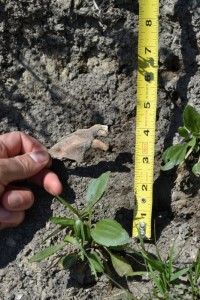Two Camosun College students were recently given the unique opportunity of presenting at an annual geoscience conference.
The conference, held in Victoria in June, was the 17th annual Meeting of the Pacific Northwest Section of the National Association of Geoscience Teachers (NAGT).
Among the presenters was first-year Environmental Technology student Julio Flores.
A few months ago Flores made an interesting discovery during a geoscience field trip: he found a now-extinct Salish Wool Dog bone. Flores says it was a nerve-wracking experience presenting his research at the conference, but given the chance he would do it again without hesitation.

“It was a good overall experience and I feel honoured to be able to be a part of it,” he says. “I’m game to doing it again, now that I know how to approach it, to make it a little easier, a little better.”
To be able to present a finding at a geoscience conference as a first-year student is an amazing experience, says Flores. He says that it provided a platform to begin refining the scientific process of discovery.
“It’s exciting to tell the story,” says Flores, “but at the same time you want to stick to being scientific about it. It was a good overall experience, and I feel honoured to be able to be a part of it.”
The second student from Camosun to present his research was second-year Environmental Technology student Alex Semple.
Semple’s presentation was on the precarious situation of some of Victoria’s newest waterfront properties. His research involved the instability of cliffside waterfront properties, which are in the process of erosion.
Although Semple was pleased about the opportunity to present his research, he got the most out of spending time with people working in his chosen career.
“I really enjoyed just getting to see the type of people or the type of atmosphere in geology,” says Semple. “I think that there was a really nice spread of people, and that everyone is very passionate and keen.”
Semple says any doubts he had about going into geoscience as a career are gone after the conference.
“It’s a cool atmosphere when everyone is clearly an expert at what they do but still have a very fun, engaging attitude,” he says. “It didn’t feel like a lecture or a seminar where these people are standing in front of you just talking to the room. It felt more like sitting at the bar with a bunch of friends, having a couple of pints and talking about whatever it is they’re up to.”
The professor who organized this year’s conference and made it possible for Flores and Semple to attend was Camosun Geoscience instructor Tark Hamilton. Victoria doesn’t often host the geoscience conference, Hamilton says, so it was fortuitous that he had two great students who were keen enough to attend.
“I had two students who did remarkable enough things to present their own self-driven research in geoscience,” says Hamilton. “They both seemed very happy, and it was a professional job the way that they presented,” says Hamilton. “Most people find public speaking terrifying and they both did well, in spite of that.”
Hamilton says he invited both students to present at the convention with the intention of giving them a leg up in starting their careers in science.
“It’s a chance to build these skills and, ultimately, we are trying to make better-educated citizens and better communicators. That’s what this NAGT group is about,” says Hamilton. “None of us may be stunning teachers, or stunning scientists, or doing cutting-edge anything, but we are learning as we go along, and we really care about involving students and making a better-informed public. It’s a good place for a first paper.”
WEB-EXCLUSIVE BONUS:
Read both students’ abstracts here:
1: Julio Flores
2: Alex Semple
